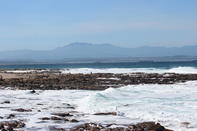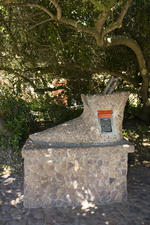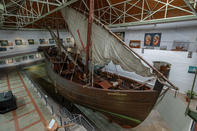An Unofficial Maritime Post Office
Historically speaking, Mossel Bay is the place where Bartolomeu Dias first planted his European-shod feet on African soil. He took this giant leap to access a stream of fresh water, which he spied springing out of the slopes facing the bay.

Luckily, the natives were friendly enough and, over the years, Mossel Bay became a regular stop-over for the early seafarers. It was so popular, in fact, that it became an unofficial maritime post office. It worked like this: sailors passing from Europe to the East would pop their notes, missives or epistles inside an old boot or bottle.
They would then tie the container to a large Milkwood tree close to the fresh water spring. The next ship that came sailing down from the East, back to Europe, would then collect the mail from the tree and deliver it to the recipients back home. It was an effective, symbiotic system, and it’s a pity that modern postal communications are no longer seen as a collaborative effort.
The Post Office Tree

The Post Office Tree still stands in the grounds of the Dias Museum Complex and, at the foot of the tree, there is a special post box shaped like a boot where you can post your modern letters and postcards. Any mail posted in the boot gets a special franking mark, but the speed with which the mail is delivered doesn’t seem to have improved much over the last few centuries.
The Post Office Tree is only one of the attractions that makes the Bartolomeu Dias Museum Complex a very worthwhile stop. It consists of several buildings which collectively house South Africa’s largest shell museum, the Post Office Tree and the original fresh water spring used by the Portuguese.
It also has a recreation of the old Mossel Bay granary, which now contains a cultural history exhibit of life in the old town, and an ‘ethno-botanical’ garden with a Braille trail for the visually impaired.
Several important Malay graves, a collection of old houses in Munro Bay and an excellent maritime museum are all located within the large museum grounds. This is also the location of the first Christian shrine in South Africa, built by a passing sailor in 1501.
The Maritime Museum

The highlight of the complex, however, is the Maritime Museum which has interesting exhibits on the early Portuguese explorers, and a life-size replica of the ship that Dias used to sail around the tip of Africa. It’s worth paying the small premium that will grant you access to the boat, so that you can walk around its tiny deck and creep below to see the cramped living quarters.
It seems impossible that this little shoebox with sails could have taken Dias from the Algarve all the way to Mossel Bay. It’s even more remarkable to think that the current replica in the museum completed the same sea journey in the 1980’s. The old-fashioned Caravel now on display was actually built from scratch by a Portuguese shipyard to celebrate the 300th anniversary of Dias’ landing.
The caravel was completed, using traditional implements and materials, and then sailed to its current location by an intrepid crew. When the shallow-draft vessel finally reached Mossel Bay in 1988, it was greeted by an ecstatic crowd, and a whole brigade of proud Nationalists (including onse eie P.W. Botha) waved their old ‘oranje, blanje, blou’ flags in commemoration of the white man’s first toe-hold in South Africa. The caravel was then plucked from the sea and installed in its new museum dry-dock, with all due pomp and circumstance.
 Mossel Bay lies on the southern coast of South Africa halfway between Cape Town and Port Elizabeth, and is a sheltered coastal village, once...
Mossel Bay lies on the southern coast of South Africa halfway between Cape Town and Port Elizabeth, and is a sheltered coastal village, once...